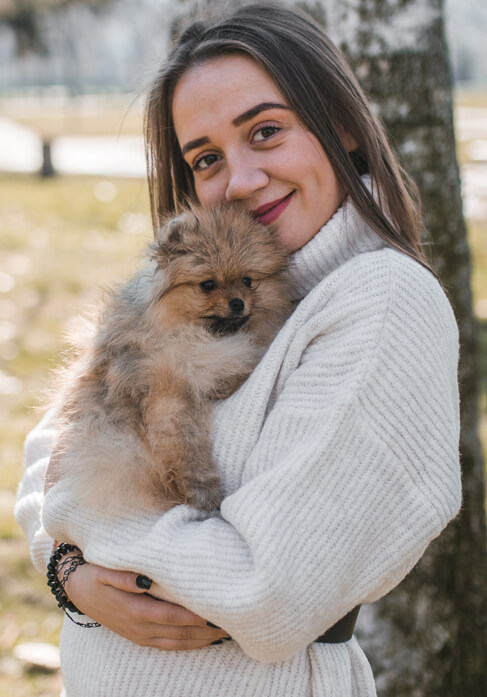Privacy Policy: Your email address is 100% safe.
We don't spam and hate it as much as you do :-) You can also unsubscribe from our mailing list at any time.

Sign Up
Teacup Pomeranian: Health, Diet, LifeSpan, Temperament

Country of Origin, History of Teacup Pomeranians
The breed we know as the Pomeranian originated in the regions surrounding Russia and Siberia and is known as a Spitz-type dog. It shares relatives with other Spitz-type breeds like the Keeshond and Samoyed among others.
These breeds were originally bred to serve as sled dogs as well as alert and guard dogs, although the smaller varieties were more likely companion and alert dogs. The Arctic conditions of its origin helped to create the thick, luxurious coat Pomeranians possess for warmth.
The Pomeranian was a larger dog than we currently know it, but as it traveled to Europe and England, its size increasingly reduced. Upon arrival in England sometime in the 18th century, it began to draw attention and even joined the ranks of Royalty with Queen Charlotte and then Queen Victoria helping to make it one of the most popular toy breeds.
The teacup size of the Pomeranian is not a recognized size class but instead refers to a Pomeranian that is smaller than its breed standard. Teacup sized Pomeranians are produced in a normal litter, and a breeder cannot guarantee the dog’s adult size.
Teacup Pomeranian Tools
Breed Selector Tool - is the Teacup Pomeranian the right breed for you?
Is the Teacup Pomeranian the right breed for you and your family?
Find out by using our Free Dog Breed Selector Tool
Check Your Teacup Pomeranian's Learning Style
Are you aware dogs also have a learning style that can greatly affect their ability to housetrain as well as be trained correctly. Evaluate your Teacup Pomeranian's learning style and personality using our free Learning Style tool so that you are better able to provide him with the proper Teacup Pomeranian training methods.
Is your Teacup Pomeranian dominating over you?
Does your Teacup Pomeranian bark unnecessarily? Does your Teacup Pomeranian come to you when you call? Download a FREE Report on Dog Dominance for you and your Teacup Pomeranian and learn how to control your dog.
Do you make these mistakes with your Teacup Pomeranian?
Are you inadvertently snow-balling bad behavior in your Teacup Pomeranian? Evaluate your Dog Training Style from our Free Tool and learn how best to deal with your dog.
Teacup Pomeranian Calorie Calculator
Do you know how many calories your Teacup Pomeranian needs every day and how many cups of food you should be giving it every day? Click here to use our Teacup Pomeranian Calorie Calculator.

The Teacup Pomeranian is a smaller version of the toy breed known for its fox-like expression. Its face is short muzzled with large almond shaped eyes. Tiny pricked ears peek out of it's head.
The Pomeranian has a tail different from its other Spitz-type dog relatives in its tail set. Most Spitz breeds carry their tail up and over their back, usually in a curled fashion. The Pomeranian also has a high tail carriage, but it lies flat over the back, not curled.
Everything about a Teacup Pomeranian is compact from its short body length to its cat-like feet. This is truly one tiny dog!
Coat:
Teacup Pomeranians have a thick woolen coat with a dense undercoat.
Coat Color:
Teacup Pomeranians come in a wide variety of colors with a bright orange being one of the most popular and known color varieties. You will also find coats in colors like: cream, white, black, chocolate, parti-colored (white with spots), and black and tan being some of the more common variations.
Toy Pomeranians
Weight: 3-7 pounds
Height: 8-11 inches
Teacup Pomeranians
Teacups are the smallest of the small Pomeranians
Weight: Max 4 pounds
Some Pomeranians can be seen as slightly oversized dogs but those breeders that breed to a standard maintain dogs under 7 pounds. Females are often larger than males.



Free Teacup Pomeranian Training Secrets
Free Course on Teacup Pomeranian Training & Obedience
Stop All Bad Behavior, Excessive Barking and Biting
Teacup Pomeranian Personality Traits

Pomeranians can have a lively and fun personality that can be contagious. They have an adorable teddy bear quality that makes many people want to lavish affection on them. There are some Pomeranians that are more independent, stubborn, or prefer less doting. It is always important to visit with a breeder about his/her dogs to insure you are matched with a compatible personality.
With proper socialization and training, he can make a delightful companion. Motivation based training begun early can be a rewarding experience and quite a few Pomeranians of the toy size compete in agility and obedience successfully!
It is perhaps more important with the Teacup Pomeranian to make sure that training is part of your life with your dog. Many small dogs are not given proper instruction, and many Pomeranians will quickly assert themselves.
Better suited to an indoor or outdoor lifestyle?
The Teacup Pomeranian can thrive in a lot of diverse environments but is probably best suited to a household with no young children due to their fragility. Most breeders will not recommend a teacup sized Pomeranian for families with young children. Teacup sized dogs can be easily hurt and must be handled with great care.
An indoor home is best for the Teacup Pomeranian, and he can be an excellent apartment dog, although he will likely need to be housetrained to litter, pads, or alternate means. Some Pomeranians can be a little barky, so work early to provide plenty of exercise, play time, and mental stimulation to reduce the urge to bark.
He can get along well with other animals like cats and dogs, but any canine friends should be equally sized to avoid injury.
Training
All dogs should be trained, and you will find your Teacup Pomeranian quite trainable with patience and motivation. No harsh training! Instead, use toys and food rewards to encourage good behavior.
Due to these dogs’ small size, leash walking should probably be done on a harness to avoid damage to the dog’s throat.


Free Teacup Pomeranian Training Secrets
Free Course on Teacup Pomeranian Training & Obedience
Stop All Bad Behavior, Excessive Barking and Biting
Teacup Pomeranian Activity Level
You will find them eager participants in all kinds of activities, and they will love going places if started early. Walks can be short and much of the daily exercise can be acquired through playtime and training around the house and yard.
Never leave your dog unattended in the yard. These tiny dogs are often victim of dog thefts and wild animal attacks (like owls and coyotes), but they can also fall prey to other animals like neighborhood dogs, can easily get out of fenced yards, and can be accidentally injured or ingest something when left alone.
Grooming
The Teacup Pomeranian will benefit from daily brushing (or at least 3 times per week) with a pin or bristle brush to keep his coat tangle free. Regular maintenance of ears and toenails is a must as well. Lastly, small dogs can have terrible dental problems, so a strict schedule of tooth brushing can prevent many problems.


Free Teacup Pomeranian Training Secrets
Free Course on Teacup Pomeranian Training & Obedience
Stop All Bad Behavior, Excessive Barking and Biting
Health and Care
The Pomeranian is a fairly healthy little dog and suffers from a few things that many toys breeds do. Some of the more common are patella luxation (or slipping knee caps) and collapsing tracheas (which causes terrible honking sounds).
Some Pomeranians also suffer from coat and skin disorders often referred to as Black Skin Disease. It can have a variety of medical origins including thyroid problems, infection, etc.
In all sizes of Pomeranians, you must be careful to feed small, frequent meals to avoid Hypoglycemia. Drops in blood sugar can be dangerous, especially for Teacup Pomeranians, and can result in lethargy, seizures, and possible death.
Teacup Pomeranians should always be vet checked for any conditions that might contribute to the smaller size like heart problems, liver conditions, etc.
Teacup Pomeranians will require more care throughout their lives as there are increased risks when using vaccinations, medication, anesthesia, etc. Always consult with your veterinarian about your dog prior to giving it anything new. A very tiny dog can quickly be adversely affected.
Teacup Pomeranians should not be allowed to jump on and off of furniture to protect their fragile bones and no rough playing with people or other dogs.
Life Span: 12-15 years, if healthy.
Litter Size: Pomeranian litters are small with only 1-3 puppies in a litter.
Train Your Teacup Pomeranian To Listen To You
Get Instant Access to Your Training Now - For Free
Sign up for our Free Teacup Pomeranian Mini Course to have a housebroken, obedient dog that happily comes to you every time you call.
You'll learn new commands to obedience-train your dog as well as how to housebreak your dog in 6 days or less.
You'll also learn how to eliminate bad habits like barking, nipping or biting, jumping, or pulling on the leash.Here's just s small fraction of what else you'll learn in the course:
How to lead and think like a pack dog - the new psychology.
3 dangerous mistakes that most Miniature Pom owners make when they are trying to potty train their dogs.
The 2 main reasons why your dog barks excessively and how to control its excessive barking.
How to obedience train your Teacup Pomeranian to permanently end behavioral problems like Jumping, Aggression, Pulling on Leash.
A surprisingly easy way to teach your dog cool new tricks.
How to improve your dog's lifespan and keep it from getting overly heavy with a healthy and nutritious diet.
Getting Pro help fast - how to get access to our expert trainers when you need them most.
One hidden psychological trigger that all Teacup Pomeranians have... that practically allows you to "analyze" and "control" your dog's every action.
Priority access to the free online seminars conducted by our training experts.
Whereas other dog training related web sites and books offer generic information for dogs in general, ours is the ONLY web site that offers Miniature Pom information specifically, from a renowned panel of experts - because as you probably know, Miniature Poms have their own special training requirements that other dogs don't have.
Our Dog Experts
The Teacup Pomeranian training information you will read here was developed by a panel of renowned dog training experts whose combined wisdom represents nearly 100 years of specialist experience training dogs.
Here are a few of our experts:




